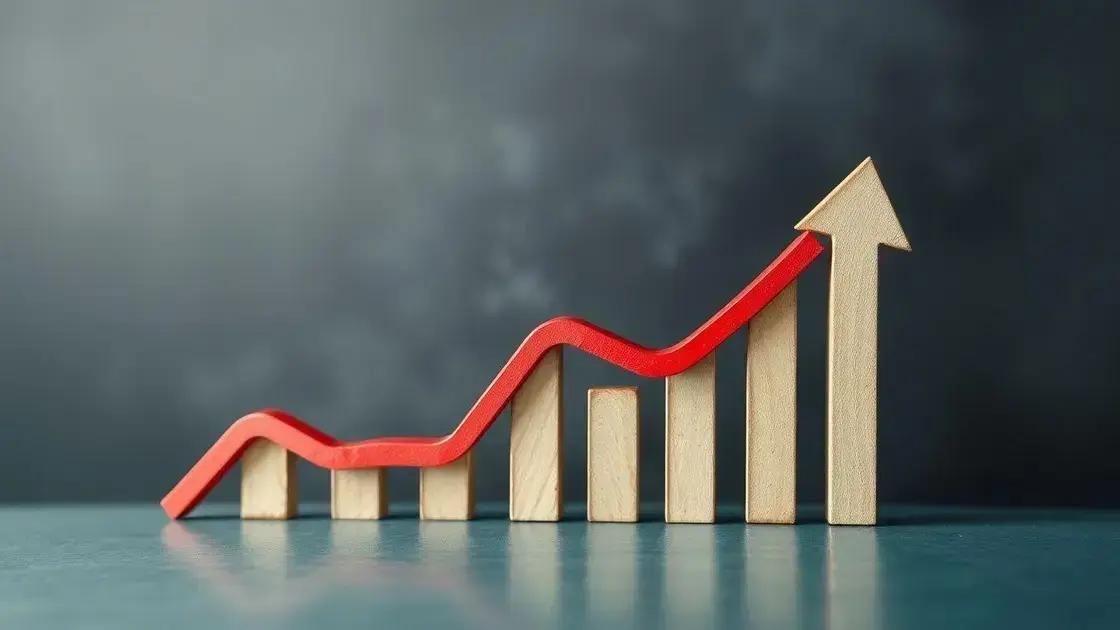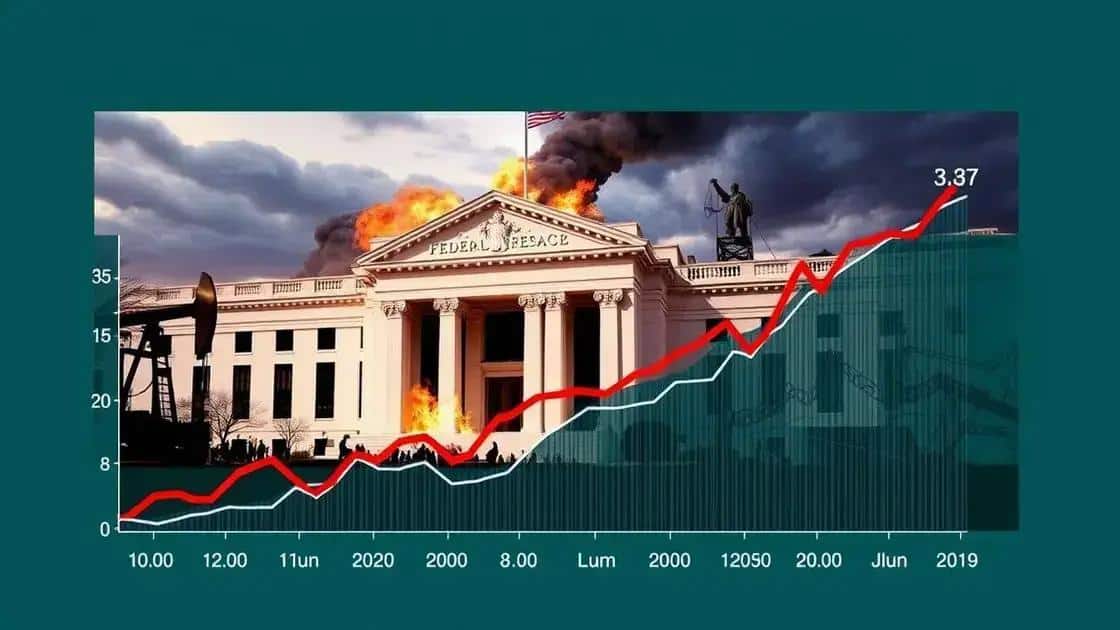Inflation trends in the US: What you need to know

Inflation trends in the US show how rising prices impact consumer behavior, prompting cautious spending, changes in purchasing habits, and the need for strategic financial planning.
Inflation trends in the US play a crucial role in shaping the economy and influencing our daily lives. Have you noticed how prices seem to rise over time? Let’s explore what these trends mean for you.
Understanding inflation rates in the US
Understanding inflation rates in the US is essential for making informed financial decisions. These rates represent the percentage increase in prices over time. Inflation affects everything from your grocery bills to housing costs.
Monthly fluctuations can often obscure underlying trends. For instance, in recent years, we’ve seen significant spikes in inflation due to various factors including supply chain issues and increased demand. Keeping track of these changes helps consumers and businesses alike.
Factors Influencing Inflation Rates
Inflation is influenced by several factors including:
- Monetary policy set by the Federal Reserve
- Supply and demand dynamics in the market
- Global economic conditions
- Consumer expectations about future prices
Each of these elements plays a vital role in determining the overall inflation rate.
Recent Trends to Note
Over the past few years, inflation in the US has shown significant variability. From 2020 to 2021, we witnessed an unprecedented increase. This was largely due to the economic disruptions caused by the COVID-19 pandemic, leading to a combination of high demand for goods and limited supply.
Examining different sectors reveals how inflation impacts various aspects of our lives. For instance, energy prices surged sharply, leading to higher costs at the pump and rising utility bills. Meanwhile, wages have also been affected, often trailing behind inflation rates, which can squeeze household budgets.
By critically analyzing these trends and their causes, you can better understand how to manage your finances and anticipate future changes in the marketplaces.
How to Keep Track of Inflation Rates
Staying informed about inflation is crucial. Here are a few methods to monitor these rates:
- Follow monthly reports from the Bureau of Labor Statistics
- Read financial news articles
- Analyze charts that display historical inflation data
This knowledge will empower you to respond effectively to economic shifts.
Historical context of inflation trends

The historical context of inflation trends in the US provides valuable insight into how the economy evolves. Understanding past inflation can help us anticipate future trends. Many factors shape inflation, including economic policies, global events, and shifts in consumer behavior.
Throughout history, the US has experienced significant periods of inflation and deflation. For example, during the 1970s, inflation rates soared due to oil crises and increased demand. This period is often remembered for its high prices of basic goods and services, which deeply affected American households.
Key Historical Events Affecting Inflation
Several key events have significantly influenced inflation over the decades:
- The Great Depression caused deflation and economic downturn.
- World War II led to price controls and post-war inflation.
- The oil embargo in the 1970s dramatically increased energy prices.
- The 2008 financial crisis initially led to a brief decrease in inflation rates.
Each of these events reshaped the economic landscape and provided lessons on managing inflation.
The Role of Monetary Policy
Monetary policy has been a crucial component in controlling inflation over the years. The Federal Reserve plays a key role in shaping this policy. During high inflation periods, the Fed often increases interest rates to cool down the economy and curb spending. Conversely, in times of low inflation or deflation, lowering interest rates can stimulate borrowing and spending.
For instance, after the 2008 financial crisis, the Fed implemented policies to keep interest rates low, encouraging spending and investment. This event showcases how central bank policies can directly influence inflation trends. By analyzing these policies and their outcomes over time, we gain a better understanding of inflation dynamics.
How inflation affects consumer behavior
Understanding how inflation affects consumer behavior is crucial for both individuals and businesses. When prices rise, consumers tend to adjust their spending habits, which can impact the overall economy. The way people react to inflation can change their buying patterns and financial decisions.
One common response to inflation is that consumers become more cautious with their purchases. This usually leads to a decrease in non-essential spending. For instance, families may choose to cut back on dining out or luxury items, focusing instead on basic necessities.
Changes in Buying Patterns
When inflation rises, several key changes can occur in consumer behavior:
- Increased price sensitivity leads to comparing prices more frequently.
- Consumers may switch to cheaper brands or alternatives.
- People often delay big purchases, such as cars or homes, until prices stabilize.
- There is a noticeable shift towards budgeting and saving over spending.
These changes reflect a general anxiety about economic stability and personal finances.
Impact on Saving and Spending Habits
Inflation can also lead to changes in how consumers handle savings. When prices are rising, the value of money decreases, which can motivate people to spend rather than save. This is because the longer money sits in a low-interest savings account, the less purchasing power it holds.
Conversely, some consumers may seek to invest in assets that traditionally hold value during inflationary periods, such as real estate or commodities. By doing this, they can protect their wealth from devaluation caused by inflation.
Through understanding these behaviors, businesses can better tailor their strategies to meet changing consumer needs. Ultimately, recognizing how inflation influences purchasing decisions can lead to smarter financial planning for everyone involved.
Future predictions for US inflation trends

Future predictions for US inflation trends are crucial for consumers, businesses, and policymakers. As the economy continues to evolve, understanding these trends can help individuals make informed financial decisions. Various factors will influence how inflation progresses in the coming years.
Economists often analyze past data and current events to forecast future inflation. For instance, trends in employment, supply chain disruptions, and government policies all play significant roles in shaping these predictions. A strong job market can lead to increased consumer spending, potentially driving inflation higher.
Key Indicators to Watch
There are several important indicators that can signal changes in inflation:
- Consumer Price Index (CPI) measures how prices change over time.
- Producer Price Index (PPI) tracks the changes in prices received by producers.
- Employment rates help assess economic growth and demand for goods and services.
- Federal Reserve policies directly impact interest rates and money supply.
Monitoring these indicators helps stakeholders anticipate changes in inflation, enabling better financial planning.
Potential Influences on Future Inflation
Several factors could influence the trajectory of inflation in the US. For example, ongoing supply chain issues can create shortages, leading to higher prices. Additionally, if demand continues to increase but supply remains constrained, inflation may rise.
Another critical aspect is monetary policy. If the Federal Reserve decides to increase interest rates to combat rising inflation, it could slow economic growth. Conversely, maintaining low-interest rates could stimulate spending but risk higher inflation. Understanding this balance is essential for grasping future inflation trends.
As consumers and businesses navigate these changes, staying informed will be key. Being proactive allows for better financial decision-making in uncertain times.
\n
| Understanding Inflation 📈 | Vital for financial planning |
| Monitor Key Indicators 📊 | CPI, PPI, and employment rates |
| Adapt Shopping Habits 🛒 | Focus on essentials during inflation |
| Plan for the Future 🔮 | Be proactive about finances |
| Stay Informed 📚 | Knowledge leads to security |
\n
\n
FAQ – Frequently Asked Questions about Inflation Trends in the US
What is inflation and why is it important?
Inflation is the rate at which prices for goods and services rise, leading to a decrease in purchasing power. Understanding inflation is crucial because it affects household budgets, investments, and economic stability.
How can I track inflation trends?
You can track inflation trends by monitoring the Consumer Price Index (CPI) and the Producer Price Index (PPI). These indicators provide insights into price changes over time.
How does inflation affect my purchasing decisions?
When inflation rises, people may become more cautious about spending, prioritize essential purchases, and look for cheaper alternatives to manage their budgets effectively.
What can I do to protect my finances from inflation?
To protect your finances, consider investing in assets that typically hold value during inflationary periods, such as real estate or commodities, and keep an eye on interest rates to make informed decisions.






